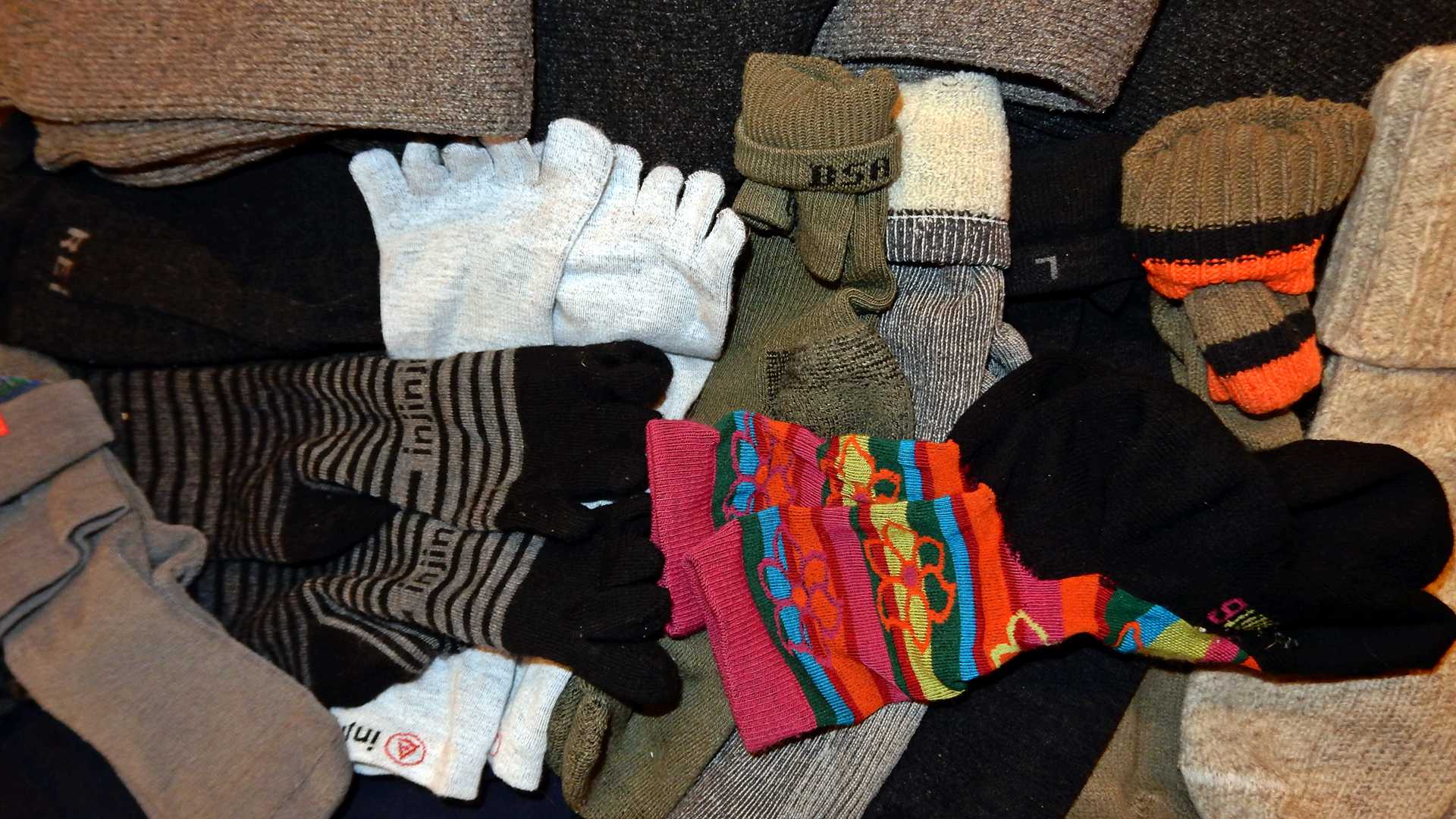Podcast: Download (Duration: 27:40 — 28.2MB)
Show Notes: Episode 051 HEEL TO TOE: The Sock Episode
Today on The First 40 Miles, HEEL TO TOE: The Sock Episode! On the Top 5 List, we’ll share the top 5 non-traditional hiking socks. Then on the SUMMIT Gear Review, the socks have invited a special guest to join them on the show. Next, on the Backpack Hack of the Week, what to do if a forest creature takes off with your socks. We have a Backpacker Q+A about compression socks. And we’ll wrap up the show with a little trail wisdom from a Russian who probably knew a thing or two about Portyankis.
Opening
What to look for:
- Blend of materials to increase durability, stretch, and wicking
- Wicking
- Reinforced heel and toe (durability)
- No toe seem (comfort)
- Cushioning (if desired)
- Arch band (helps keep sock in place, decreases fatigue)
Top 5 Non-Traditional Hiking Socks
Waterproof Socks
- If you’re interested in waterproof socks, check out the Hanz Lightweight Waterproof Socks (great for winter backpacking) (They also make gloves)
- Takes a bit of getting used to because it’s not going to fit like a traditional sock and have stretch in all the places you’re used to.
- The Hanz Waterproof Socks have a wicking layer so it won’t feel like you’re wearing a plastic bag, and a stretchable waterproof membrane, and a cover for that membrane. They’re all fused together. No ridges or seems, but like I said it still takes some getting used to.
- Great if you’re going to be doing some slogging and all you want at the end of the day is dry feet.
Compression Socks
- We’ll talk about this in more detail in our Backpacker Q+A later in the show
- Vim & Vigr makes some really nice wool compression socks, as well as wicking nylon socks. Great looking stuff that you may not see at the outdoor store, but is performance gear for sure. Appeal more to women backpackers…
Silk Liner Socks
- Liner socks are ultralightweight
- Not meant to be used alone, but they can be
- Used silk liner socks along with body powder for extra friction protection
- Great option for hot weather
Toe Socks
- Injinji is the brand you’re probably most familiar with.
- Toe socks are like gloves for your feet. You put your toes in first, then slide the rest of the sock up your foot.
- Toe socks are designed to keep toes from rubbing against each other—which can form blisters.
Double Layer Sock
- The brand you may know best is Wrightsock
- Some people love double layer socks
- Rather have two pair of socks, than one with two layers.
SUMMIT Gear Review™: TELIC Recovery Shoes
Structure
- Four different styles: Flip Flop, Z Strap (z across the top of foot), Slide (house shoe), Dream (top of foot is covered with the exception of side air vents)
- Contoured to support the arches of your feet, all styles feature a deep heel cup with great medial arch and metatarsal support.
- Novalon, which is a proprietary material that is extremely durable,
- Made in USA
- Soft, yet supportive
- Lightweight
- Not much tread on bottom of shoe, so wouldn’t recommend for river crossing
Utility
- Completely waterproof
- Heat-activated
- If you get the Z strap, Slide or Dream then you can wear them with socks.
- Textured footbed, but not deeply textured like those massage shoes
- The perfect recovery shoe for strenuous activity
Mass
- Roughly 8-12 ounces a pair, depending on size and style
- All shoes are unisex but are sized according to traditional men’s and women’s shoe sizes
Maintenance
- Machine washable
- Air dry
Investment
- $40-50 depending on the style
Trial
- We gave them to members of our group on our last trip, and had them test out a pair of Telics
- One girl wore them as her primary hiking shoe for one day.
- These shoes are comfortable, durable, lightweight and supportive.
Backpack Hack of the Week™: Portyanki, Fußlappen or Footwraps
- This isn’t necessarily something we recommend, but it’s more like a history lesson that you’re welcome to try out on your feet. Back before socks were all the rage, people figured out that you could wrap your feet with cloth. It does a decent job of keeping dirt out and is easy to wash.
- 300 years of Russian Military history
- The German Army also has a variety of footwrap that used a smaller square piece of fabric.
- Take a bandana, place your foot in the center, diagonally. Then bring up the corner over your toes. Wrap the right corner over your foot, and tuck it under your arch. Wrap the other corner over your foot and put your shoe on.
Backpackers Q+A: Compression Socks
“I have hiking socks and liner socks, but a friend who runs recently ask me if I used compression socks. Can you tell me if it’s something worth buying for backpacking?”
The reason people sometimes recommend compression socks, is because compression socks are designed to help improve circulation, which helps with muscle recovery. Some diabetics use special compression socks because many suffer from circulation issues that can cause swelling in their feet, ankles or legs.
Hikers can have times where they experience swelling in their feet, ankles or legs. So the question is: Are compression socks the best solution to that problem on the trail? Are there any other options?
When you’re hiking, circulation in your feet and legs aren’t a huge issue—so compression socks aren’t necessary. Plenty of circulation is going on while you’re hiking.
However, it’s when you stop that things start to slow down, and you could experience swelling. So, compression socks may be something that you want to try for wearing around the camp after you’re done hiking for the day.
Trail Wisdom
“These people have learned not from books, but in the fields, in the wood, on the river bank. Their teachers have been the birds themselves, when they sang to them, the sun when it left a glow of crimson behind it at setting, the very trees, and wild herbs.”
― Anton Chekhov

